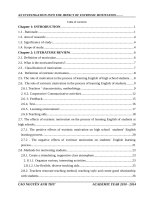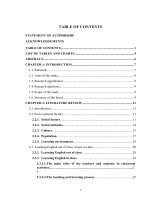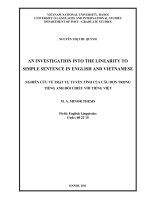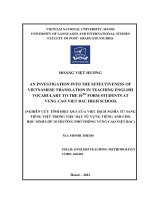An investigation into the vietnamese translation of english adverbs and adverbials as employed in to kill a mockingbird by harper lee
Bạn đang xem bản rút gọn của tài liệu. Xem và tải ngay bản đầy đủ của tài liệu tại đây (423.17 KB, 26 trang )
THE UNIVERSITY OF DA NANG
UNIVERSITY OF FOREIGN LANGUAGE STUDIES
NGUYỄN NỮ THANH THẢO
AN INVESTIGATION INTO THE VIETNAMESE
TRANSLATION OF ENGLISH ADVERBS AND
ADVERBIALS AS EMPLOYED IN
TO KILL A MOCKINGBIRD BY HARPER LEE
Major: ENGLISH LINGUISTICS
Code: 60.22.02.01
MASTER THESIS IN
SOCIAL SCIENCES AND HUMANITIES
(A SUMMARY)
Da Nang, 2017
This thesis has been completed at University of Foreign Language
Studies, The University of Da Nang
Supervisor: Lê Thị Giao Chi, Ph.D
Examiner 1 : Assoc.Prof. Lâm Quang Đông
Examiner 2 : Trần Quang Hải, Ph.D
The thesis was be orally defended at the Examining Committee
Time : 09/09/2017
Venue : University of Foreign Language Studies
- The University of Da Nang
This thesis is available for the purpose of reference at :
- Library of University of Foreign Language Studies,
The University of Da Nang.
1
CHAPTER 1
INTRODUCTION
1.1. RATIONALE
It is not easy to know when literature itself dated from.
Perhaps, it began just as human beings had their reclamation to gain
their world, or on a journey of discovery to conquer and dominate the
nature for human society formation. Up to now, literature has always
played an important role in our spiritual and social life in all times. It
is a tool of knowledge, discovery, and ideologies about the world.
Literary translation is an activity not to be considered as an
impossible task or looked down upon as less creative than writing
poetry or fiction. The necessity of translation service is dramatically
acute in our modern word. Not only do nations depend on it to bridge
what would otherwise an impossible communication gap but it also
accommodates human access to the wealth of global scientific and
technology information, as well as to the ideas that shape our society.
The basic concept of translation is to find equivalence that
preserves features of the original meaning or message, applied to
every kind of text forms. Therefore, the words, phrases, clauses,
sentences, and paragraphs from the source language can be translated
into the target language in the way that the message can be retained.
This means the original meaning should not diverge from what is
presented in the target language.
However, the structure of each language is naturally
different from one another. This means the translator, in the quest
for retaining the original message conveyed in the source text needs
to make necessary or different procedures in translation, so that
equivalence in communication across the two languages can be
2
achieved. This translation phenomenon also occurs in translating
parts of speech in some texts. In every language over the world, it is
generally known that parts of speech have several classes: verbs,
adjectives, nouns, adverbs, adverbials, pronouns, conjunctions,
prepositions, and interjections. Almost all sentences contain adverbs
so as to add more specific information about place, time, manner,
cause or degree to a verb, an adjective, a phrase or another adverb.
However, there have sofar not many adequate studies investigating
the function as well as the translation of English adverbs and
adverbials into Vietnamese, especially in texts of a literary type. As
a result, the likelihood of frequent confusion facing many students
of English might probably stem from the differences in the part of
speech in English and Vietnamese. This study aims at analyzing the
similarities and differences between the two languages in expressing
the meaning by means of adverbs and adverbials, and ultimately
putting forward some suggestions on how they can be effectively
used in communication.
A novel entitled To Kill a Mockingbird is not an exception.
It has been intensively read in recent years, and it can be taken as a
typical piece of writing which is characterististic of the literary genre.
As the novel contains many adverbs and adverbials being used,
the Vietnamese translation of these adverbs and adverbials can
be more than a problem to language learners and readers. For the
effect of equivalence in translation, readers may expect some
necessary adjustments or alterations made in the target language
in term of lexical or structural means. For example:
SL: Atticus said dryly, ‘Do not let this inspire you to
further glory, Jeremy’. (Chaper 8)
TL: Bố nói khơ khan, “Đừng lấy chuyện này làm vinh
3
quang, Jeremy.”
In this example, we can see that the ST verbal structure verb
+ adv has been rendered into the TT verbal structure verb+adj, which
shows a shift in verb structure, according to Catford’s taxonomy
(1965/2000). More specifically, the adverb of maner in the ST has
been translated into adjective in the TT, that is, the adverb dryly is
replaced by an adjective khô khan in the TL. Here, we can see a
common procedure adopted in translation which is transposition
(Vinay& Darbelnet 1995/2000), where the translator replaces one
word class with another without changing the message.
As the process of going from one language into another can
involve a number of problems which are due to the differences
between the two languages in terms of word classes or procedures
that the translator needs to undergo is deemed as important as the
ultimate goal of any work of translation is to preserve the
communicative effect. Hence, the topic An investigation into the
Vietnamese translation of English adverbs and adverbials as
employed in To Kill a Mockingbird by Harper Lee is thus to be
carried out in the hope that better insight into the various
representations of English adverbs amd adverbials can be recognized
once the novel is translated into Vietnamese.
1.2. AIMS AND OBJECTIVES
1.2.1. Aims
The aim of the study is to investigate the kinds of adverbs
and adverbials used in the novel entitled To Kill a Mockingbird by
Harper Lee. It looks at how these adverbs and adverbials are
translated into Vietnamese as manifested in the Vietnamese version
by Huỳnh Kim Anh and Phạm Viêm Phương and what procedures
have been adopted in the Vietnamese translation of these adverbs and
4
adverbials.
-
-
1.2.2. Objectives
For the above aim to be achieved, the following objectives
are set:
To examine the process of translating English adverbs and
adverbials in the novel To Kill a Mockingbird into
Vietnamese;
To identify the procedures adopted in translating these
English adverbs and adverbials into Vietnamese;
To work out the most common procedure adopted in the
Vietnamese translation of English adverbs and adverbials as
employed in the novel To Kill a Mockingbird by Harper Lee.
1.3. RESEARCH QUESTIONS
The study has been carried out to answer the following
questions:
1. How are English adverbs and adverbials in To Kill a
Mockingbird by Harper Lee translated into Vietnamese?
2. What procedures have been adopted in the Vietnamese
translation of English adverbs and adverbials in the novel To Kill a
Mockingbird by Harper Lee?
3. What is the most common procedure adopted in the
Vietnamese translation of English adverbs and adverbials in the
novel To Kill a Mockingbird by Harper Lee?
1.4. SCOPE OF THE STUDY
Due to the limitation of time, ability, and conditions, I only
wish to concentrate on investigating the Vietnamese translation of
English adverbs and adverbials in the novel To Kill a Mockingbird by
Harper Lee. Therefore, this research focuses on a sample of 250
adverbs and adverbials used in To Kill a Mockingbird in the first
5
eight chapters written by Haper Lee and their Vietnamese
equivalents. So, in this study, I used Vinay and Darbelnet’s
methodology of translation, especially the two procedures –
transposition and modulation – which are used as analytical tool for
the analysis of how adverbs and adverbials in the corpus are
translated into Vietnamese, and what procedures have been adopted
in translation.
1.5. JUSTIFICATION FOR THE STUDY
Hopefully, making an investigation into the Vietnamese
translation of English adverbs and adverbials in To Kill a
Mockingbird will be a contribution to the existing knowledge of the
field. And findings of the procedures used in translating English
adverbs and adverbials will be expected to be of great value to
Vietnamese learners of English.
1.6. ORGANIZATION OF THE STUDY
The study is organized into five chapters including:
- Chapter One “Introduction.
- Chapter Two “Literature Review and Theoretical Background” .
- Chapter Three “Research Design and Methodology”.
- Chapter Four “Discussion of Findings” .
- Chapter Five “Conclusion – Implications – Recommendations”.
CHAPTER 2
LITERATURE REVIEW AND
THEORETICAL BACKGROUND
2.1. LITERATURE REVIEW
Translation is a complex process where fragile balance is
achieved between the equivalence of the text translated and the
6
linguistic means chosen. In reality, translation from English into
Vietnamese is a complex work which poses great difficulties to the
translator but there are a few researchers dealing with adverb
translation. There are researchers who have done analysis about
language translation and the process of translation from English into
Vietnamese.
By means of researches, many problems of translation have
been revealed. At first there are various methods and procedures of
translations, yet according to Nida and Taber (1969/1982)’s
methodology for translation. Therefore, adverb has also frequently
been a subject matter of study among writers and teachers. Actually,
English adverb has been paid much attention and described by such a
lot of grammarians like Walker and Elsworth (1988), Laurie Rozakis
(2003), Haln and Hensley (2000), and so on. Generally, English adverb
is studied concerning three perspectives, theoretical, practical, and and
functional, and the most detailed pictures of English adverb are offered
by Eastwood (1992), Quirk (1973) and Greenbaum (1985).
2.2. THEORETICAL BACKGROUND
2.2.1. Definition of Translation
Translation, by dictionary definition, consists of changing
from one form to another, to turn into one ‘own or another’ language
(the Merriam-Webster Dictionary, 1974). Some authors have given
the following different definitions of translation.
2.2.2. Equivalence in Translation
Equivalence is defined as a central concept in translation
theory. Vinay and Darbelnet (1995) [28] view equivalence-oriented
translation as a procedure which replicates the same situation as in the
original, whilst using completely different wording. They also suggest
that, if this procedure is applied during the translation process, it can
maintain the stylistic impac of the SL textin the TL text.
7
2.2.3. Translation Methods
According to Newmark, there are eight types of translation:
- Word-for-word translation
- Literal translation
- Faithful translation
- Semantic translation
- Communicative translation
- Idiomatic translation
- Free translation
- Adaptation
2.2.4. Procedures of Translation by Vinay and Darbelnet
a. Borrowing
b. Caique
c. Literal Translation
d. Transposition
e. Modulation
f. Adaptation
g. Equivalence
2.2.5. Part of Speech
2.2.6. Adverbs and Adverbials in English
2.2.6.1. Adverbs in English
a. Definition
b. Functions of Adverbs
+ Adverbs of manner
+ Adverbs of place
+ Adverbs of
+ Adverbs of time
c. Position of Adverbs
2.2.6.2. Adverbial in English
a. Definition
8
b. Function of adverbial
+ Adverbials of manner
+ Adverbials of condition
+ Adverbials of purpose
+ Adverbials of cause
+ Adverbials of concession
+ Adverbials of time
+ Adverbials of place
+ Adverbials of circumstances
2.2.7. Adverbs and Adverbials in Vietnamese
2.2.7.1. Adverb in Vietnamese
a. Definition of Adverb
b. Function of Vietnamese Adverbs
+ Adverbs modifying adverb
+ Adverbs modifying adjective
+ Adverbs modifying verb
+ Adverbs modifying noun
c. Position of Vietnamese Adverbs
2.2.7.2. Adverbial in Vietnamese
+ Adverbials of manner
+ Adverbials of situation
+ Adverbials of purpose
+ Adverbials of time
+ Adverbials of place
+ Adverbials of circumstances
9
CHAPTER 3
RESEARCH METHODS
3.1. RESEARCH DESIGN
- Providing some basic theoretical concepts related to
word, adverbs and adverbials, Vietnamese adverbs and adverbials,
translation and translation procedures;
- Collecting samples of English adverbs and adverbials in To
Kill a Mockingbird and their Vietnamese translations in the translated
version;
- Describing and analyzing the collected data to figure
out the translation procedures used in the act of translating;
Also, to gather data for the most commonly used procedure,
a combined qualitative and quantitative approach is used.
3.2. DATA COLLECTION
Firstly, the data was collected from ‘To Kill a Mockingbird’
by Harper Lee. A total of 500 samples have been extracted, in
which250 are of the original language – English (i.e. 200 adverbs and
50 abverbials) and 250 of the target language – the Vietnamese
translational equivalents. It is important to note that the sampled
adverbs taken for investigation came from the first eight chapters of
the novel only.
Secondly, the collected data was categorized according to
different types of adverbs and adverbials. The collected data was
then divided into different types of adverbs. After this, each
language pair, that is, the English adverb and adverbial and its
Vietnamese equivalent from the sample was analysed, based on the
chosen procedures of translation proposed by Vinay and Darbelnet .
10
3.3. DATA ANALYSIS
Firstly, the data collected was examined to discover what
types of adverbs and adverbials are used in ‘To Kill a Mockingbirds’
by Harper Lee, and how they are translated.
Secondly, the data, or rather, the Vietnamese translational
equivalents of English adverbs and adverbials, were analysed, and
and then categorised following the common procedures of translation
proposed by Vinay and Darbelnet (1958/1995) namely transposition
and modulation.
Thirdly, the data was quantitatively processed and shown in
the statistical tables.
Finally, the frequency of each procedure was displayed in the
tables.
3.4. RESEARCH PROCEDURES
CHAPTER 4
FINDINGS AND DISCUSSION
4.1. PREAMPLE OF ADVERBS AND ADVERBIALS USED IN
TO KILL A MOCKINGBIRD
4.1.1. Adverbs of Manner ( Adverbials of Manner)
4.1.2. Adverbs of Frequency
4.1.3. Adverbs of Time
4.1.4. Adverbial Phrase of Manner ( Prepositional
Phrases)
4.2. THE VIETNAMESE TRANSLATION OF ENGLISH
ADVERBS AND ADVERBIALS IN TO KILL A MOCKINGBIRD
4.2.1. Transposition
11
4.2.2. Modulation
4.2.3. The Vietnamese Translation of Adverbs in To Kill a
Mockingbird
4.2.3.1. The Procedures Used in English-Vietnamese
Translation of Adverbs of Manner in To Kill a Mockingbird
a. Transposition in Translating Adverbs of Manner
Table 4.2. The Vietnamese equivalents of Adverbs of Manner
in form of Adjectives
Adverb of Manner
(51) Hey yourself,” said
Jem pleasantly.
“I’m Charles Baker Harris,”
he said. “I can read.”
Vietnamese Equivalent
Transposition
"Chào", Jem vui vẻ đáp.
End-mid
"Tao là Charles Baker
Harris", nó nói. "Tao biết
đọc đó".
(52) Dill sighed patiently.
“I told her till I was blue in
the face where I was
goin‘— she’s just seein’
too many snakes in the
closet. Bet that woman
drinks a pint for breakfast
every morning—know she
drinks two glasses full.
Seen her.”
Dill thở dài kiên nhẫn. "Tớ
đã cố hết sức nói dì ấy tớ đi
đâu rồi đó chứ - dì ấy chỉ
thấy quá nhiều rắn trong tủ.
Tớ dám chắc bữa điểm tâm
nào dì ấy cũng uống nửa lít
rượu - tớ biết dì ấy uống hai
ly rượu. Từng thấy rồi mà."
Frontfront
(53) Little Chuck’s
contracted and he
gently, “You mean
ma’am? Yessum,
Khuôn mặt Little Chuck cau
lại và nó nói nhẹ nhàng, "Ý
cơ nói nó hả? Vâng, nó cịn
sống. Nó làm gì khiến cơ sợ
Midmid
face
said
him,
he’s
12
Adverb of Manner
Vietnamese Equivalent
Transposition
alive. Did he scare you vậy?"
some way?”
(54) He remembered her
clearly, and sometimes in
the middle of a game he
would sigh at length, then
go off and play by himself
behind the car-house
Anh ấy nhớ mẹ rất rõ, và
đôi khi đang chơi giữa
chừng anh ấy thở dài hồi
lâu, sau đó bỏ đi chơi một
mình ở phía sau nhà xe
Midmid
- Vietnamese Equivalents in Form of Noun Phrases
b. Modulation in Translating Adverbs of Manner
- Concrete for abstract
Table 4.4. The Abstract for Concrete Modulation in Translating
Adverbs of Manner
Adverb of Manner
Vietnamese Equivalent
(58) The remains of a picket
drunkenly guarded the front
yard— a “swept” yard that was
never swept— where johnson
grass and rabbit-tobacco grew in
abundance.
Tàn tích của những chiếc cọc
nhọn làm hàng rào xiêu vẹo
ở sân trước - một cái sân "để
quét" vốn không bao giờ được
quét - nơi cỏ cho gia súc và cỏ
thuốc thỏ mọc lan tràn.
(59) “He’ll be so presently,” said
Atticus. “It was a little too strong for
him.” Our father sighed. “I’m going
to bed,” he said. “If I don’t wake up
"Nó sẽ ổn thơi," bố Atticus nói.
"Chuyện này hơi sốc với nó." Bố
chúng tơi thở dài, "em đi ngủ
đây," ơng nói. "Nếu sáng mai em
13
Adverb of Manner
Vietnamese Equivalent
in the morning, don’t call me.”
không dậy, đừng gọi em."
(60) Miss Stephanie and Miss
Rachel were waving wildly at us,
in a way that did not give the lie
to Dill’s observation.
Cô Stephanie và cô Rachel đang
vẫy chúng tôi rối rít, theo một
cách cho thấy quan sát của Dill
khơng hẳn là sai.
- Negation of the opposite
Table 4.5. The Negation of the opposite Modulation in Translating
Adverbs of Manner
Adverb of Manner
Vietnamese Equivalent
(61) He said he was trying to get
Miss Maudie’s goat, that he had
been trying unsuccessfully for
forty years, that he was the last
person in the world Miss Maudie
would think about marrying but
the first person she thought about
teasing, and the best defense to
her was spirited offense, all of
which we understood clearly.
Chú nói chú đang chọc tức cô
Maudie, rằng chú đã cố gắng mà
không thành công suốt bốn
mươi năm, rằng chú là người
cuối cùng trên trái đất này cô
Maudie nghĩ đến khi muốn kết
hôn nhưng là người đầu tiên cô
nghĩ đến để chọc ghẹo và cách
phịng thủ tốt nhất của cơ là sự
xúc phạm mạnh mẽ, tất cả điều
này chúng tôi hiểu rõ.
(62) The witness realized his
mistake
and
shifted
uncomfortably in the chair. But
the damage was done.
Bị cáo nhận ra sai lầm của anh ta
và cựa quậy một cách khó chịu
trên ghế. Nhưng thiệt hại đó là
khơng thể cứu vãn.
(63) Judge Taylor cleared his Quan tòa Taylor hắng giọng và
throat and tried unsuccessfully to cố gắng một cách thảm hại để
speak in soothing tones.
nói bằng giọng nhẹ nhàng.
14
- Cause and Effect
Table 4.6. The Cause and Effect Modulation in Translating Adverbs
of Manner
Adverb of Manner
Vietnamese Equivalent
(64) “Hush, Stephanie.” Miss Thơi đi, Stephanie." Cách nói của
Maudie’s diction was deadly. cơ Maudie buồn buồn "Tôi không
“I’ve not got all the morning to phí cả buổi sáng để loanh quanh ở
pass on the porch—Jem Finch, I hiên nhà đâu... Jem Finch, cô gọi
called to find out if you and your để coi cháu và các bạn cháu có
thích ăn ít bánh khơng.
colleagues can eat some cake
(65) Jem grinned ruefully. “Wish
Jem cười đầy nuối tiếc. "ước gì
the rest of the county thought
những người còn lại trong hạt
that.”
này cũng nghĩ như vậy."
c. No Translation or Ommission
Table 4.7. No Translation or Omission in Translating Adverbs of
Manner
Adverb of Manner
Vietnamese Equivalent
(66) His white shirt bobbed over Tấm áo trắng của anh thấp
the back fence and slowly grew thoáng bên hàng rào sau nhà và
rõ dần hơn.
larger.
(67) She was rocking slowly in Cô đang đu đưa trên chiếc ghế gỗ
sồi to.
her big oak chair.
(68)
The
courthouse
Maycomb
was
County Tòa án hạt Maycomb gợi nhớ
faintly đến Arlington ở một khía cạnh.
reminiscent of Arlington in one
respect.
15
4.2.3.2. The Procedures Used in English-Vietnamese
Translation of Adverbs of Frequency in To Kill a Mockingbird
a. Transposition in Translating Adverbs of Frequency
- Vietnamese Equivalents in form of Adjunct of Comparision
Table 4.8. Vietnamese Equivalents of Frequency in form of Adjunct
Transposition
Front-front
Adverb of Frequency
Vietnamese Equivalent
(69) “Sometimes it’s
better to bend the law a
little in special cases. In
your case, the law
remains rigid. So to
school you must go.”
Đôi khi tốt hơn là nên bẻ
cong luật một chút trong
những trường hợp đặc
biệt. Trong trường hợp
của con, luật pháp vẫn
rất cứng rắn. Vậy nên
con phải đi học."
(70)Jem’s definitions are
very nearly accurate
sometimes.”
(71)The
things
that
happen to people we
never really know.
Định nghĩa của Jem đơi
khi cũng khá chính xác."
End-mid
Chúng ta khơng bao giờ
thực sự biết những gì
xảy ra với người ta.
Mid-front
(72)Every mob in every
little Southern town is
always made up of
people you know—
doesn’t say much for
them, does it?”
Mọi đám đông hung
hăng trong mọi thị trấn
nhỏ bé ở miền Nam này
luôn luôn gồm những
người con đã biết......
điều đó q bình thường
dễ hiểu, đúng khơng?"
Mid-mid
(73)I went all the way up
to the house once.
"Có lần tao dám đi một
lèo tới nhà đó ln.
Mid-front
16
b. Modualation in Translating Adverbs of Frequency
- Concrete for Abstract
Table 4.9. The Concrete for Abstract Modulation in Translating
Adverbs of Frequency
Adverbs of Frequency
Vietnamese Equivalent
(74) We were accustomed to Chúng tôi đã quen với việc nhắc
prompt, if not always cheerful nhở, nhưng không phải lúc nào
acquiescence
to
Atticus’s cũng vui vẻ nghe theo những
instructions, but from the way he chỉ thị của bố Atticus, nhưng
stood Jem was not thinking of
theo kiểu anh ấy đứng thì Jem
budging.
khơng nghĩ đến việc nhúc
nhích.
(75) Often as not, Miss Maudie Nhiều khi cô Maudie và tôi vẫn
and I would sit silently on her ngồi im lặng ở hàng hiên nhà
porch, watching the sky go from cơ, nhìn bầu trời chuyển từ vàng
yellow to pink as the sun went
sang hồng khi mặt trời lặn, dõi
down, watching flights of martins theo những đàn chim nhạn bay
sweep low over the neighborhood sà thấp trên khu phố này và biến
and
disappear
behind
the mất đằng sau mái trường học.
schoolhouse rooftops.
4.2.3.3. The Procedures Used in English-Vietnamese
Translation of Adverbs of Time in To Kill a Mockingbird
a. Transposition in Translating Adverbs of Time
- Vietnamese Equivalents in form of Adjunct of Nouns:
17
Table 4.10. Vietnamese Equivalent of Adverbs of Time in form of
Nouns
Adverb of Time
(76) He had none today
nor would he have any
tomorrow or the next
day. He had probably
never seen three quarters
together at the same time
in his life.
Vietnamese Equivalent Tran- position
Hôm nay nó khơng có và
Mid-mid
cả ngày mai hay ngày
mốt cũng khơng có ln.
Chắc cả đời nó chưa
từng thấy ba đồng hai
mươi lăm xu cùng một
lúc bao giờ.
(77)We looked yesterday
from across the street,
and there’s a shutter
loose. Think maybe I can
make it stick on the
window sill, at least.”
"Hôm qua tụi tao đứng
bên kia đường nhìn sang
thấy có một ơ cửa bị
long ra. Tao nghĩ ít ra
tao có thể nhét nó vào bệ
cửa sổ."
Mid-front
- Equivalent in Form of Ajuncts of Comparision
Table 4.11. Vietnamese Equivalents of Adverbs of Time in form of
Adjuncts
Adverb of Time
(78) Mrs. Radley ran
screaming into the street
that Arthur was killing
them all, but when the
sheriff arrived he found
Boo still sitting in the
livingroom, cutting up the
Tribune. He was thirtythree years old then.
Vietnamese Equivalent Trans- position
Bà Radley chạy ra
Mid-mid
đường gào lên rằng
Arthur sắp giết cả nhà
họ, nhưng khi cảnh sát
trưởng đến ông ta thấy
Bob vẫn ngồi trong
phịng khách, cắt tờ
Tribune. Lúc đó anh ta
đã ba mươi ba tuổi.
18
Adverb of Time
(79) Miss Caroline said
desperately, “I was just
walking by when it crawled
out of his hair… just
crawled out of his hair…”
Vietnamese Equivalent Trans- position
Cơ Caroline nói một
Mid-mid
cách tuyệt vọng, "Cơ
vừa mới đi ngang thì nó
bị từ tóc trị đó.... Vừa
mới bị ra khỏi tóc...."
b. Modulation in Translating Adverbs of Time
4.2.4. The Vietnamese translation of Adverbials in To Kill a
Mockingbird
4.2.4.1. Transposition in Transposition Adverbials (prepositional
phrases) of Manner
Table 4.13. Vietnamese Equivalents of Adverbial of Manner
in form of Noun Phrases
Adverbial of Manner
(83) I rose graciously on
Vietnamese Equivalent Trans- position
Tôi đứng dậy đàng
Walter’s behalf: “Ah— hồng
nhân
Miss Caroline?” “What Walter,
"A-thưa
is it, Jean Louise?”
Mid-mid
danh
cơ
Caroline?" "Gì đó, Jean
Louise?"
(84) Walter stood where
Walter đứng im tại chỗ,
he was, biting his lip. Jem cắn môi. Jem và tôi bỏ
and I gave up, and we đi, và khi chúng tôi gần
were nearly to the Radley đến chỗ nhà Radley thì
Place when Walter called, Walter gọi, "Nè, tao đi
“Hey, I’m comin‘!”
với!
Mid- mid
19
Adverbial of Manner
(85) Jem threw open the
Vietnamese Equivalent Trans- position
Jem đẩy tung cách cổng
Mid-mid
gate and sped to the side và đi nhanh đến hông
of the house, slapped it nhà, vỗ vào nó và chạy
with his palm and ran trở ra vượt qua chỗ
back past us, not waiting chúng tôi, không chờ
to see if his foray was xác nhận xem cuộc xâm
successful.
nhập của anh có thành
cơng hay khơng.
(86) Safely on our porch, An toàn ở hàng hiên
Front-front
panting and out of breath, nhà mình, thở hổn hển,
we looked back.
rầu rĩ và buồn bã.
(87) Because I could
Tại vì bố khơng thể u
Mid-mid
never ask you to mind cầu con nể phục bố nữa.
me again. Scout, simply Scout, đơn giản bởi vì
by the nature of the bản chất của mỗi công
work, every lawyer gets việc, mỗi luật sư trong
at least one case in his đời mình ít nhất có một
lifetime that affects him vụ tác động đến cá nhân
personally.
ông ta.
4.2.4.2. Modulation in Adverbials (Prepositional Phrases) of
Manner
- Concrete for Abstract
20
Table 4.14. Vietnamese Equivalents of Adverbial of Manner
in form of Concrete for Abstract
Adverbial of Manner
Vietnamese Equivalent
(88)We were far too old to settle Chúng tôi đã quá lớn không thể
an argument with a fist-fight, so dàn xếp một cuộc tranh cãi bằng
we consulted Atticus.
nắm đấm, vì vậy chúng tơi hỏi ý
kiến bố Atticus.
(89)when he stood or walked, the khi đứng hoặc đi, mu bàn tay
back of his hand was at right anh cứ thẳng góc với thân mình,
angles to hi0s body, his thumb ngón cái song song với đùi.
parallel to his high.
(90)Ladies bathed before noon,
after their three-o’clock naps,
and by nightfall were like soft
teacakes with frostings of sweat
and sweet talcum.
Các bà tắm trước buổi trưa, rồi
sau giấc ngủ ngắn lúc ba giờ, và
khi đêm xuống họ trông giống
như những chiếc bánh bơ mềm
phủ mồ hôi và phấn rôm ngọt.
4.3. RELATIVE FREQUENCY OF PROCEDURES USED IN
TRANSLATING ENGLISH ADVERBS IN TO KILL A
MOCKINGBIRD INTO VIETNAMESE
Table 4.15. Relative Frequency of Procedures
used in Translating English Adverbs
Procedures
Frequency
Percentage (%)
Transposition
190
76
Modulation
60
24
TOTAL
250
100
21
4.3.1. Frequency of Occurrence of Different Types of
Modulation
Table 4.16. Relative Frequency of types of Transposition in
Translating English Adverbs
Types of
Types of
Adverb
Transposition
Frequency
Adverb Adjective/
Adverbs of
Manner
Adverbs of
Time
Adverbs of
Frequency
Percentage
(%)
65
36.1
Adverb Noun Phrase
17
9.4
No Translation
22
12.2
Adverb Noun
20
11.1
Adverb Adjunct
10
5.6
Adverb Adjunct
46
25.6
180
100
Adjective Phrase
TOTAL
4.3.2. Frequency of Occurrence of Different Types of
Modulation
Table 4.17. Relative Frequency types of Transposition
in Translating English Adverbs
Types of
Types of
Adverbs
Modulation
Abstract for
Concrete
Adverbs of
Manner
Negation of the
opposite
Frequency
Percentage
(%)
16
35.6
5
11.1
22
Types of
Types of
Adverbs
Modulation
Cause and
Effect
Adverbs of
Abstract for
Concrete
Time
Adverbs of
Abstract for
Frequency
Concrete
TOTAL
Frequency
Percentage
(%)
7
15.6
6
13.3
11
24.4
45
100
4.3.3. Frequency of Occurrence of Different Types of
Modulation and Transposition
Table 4.18. Relative Frequency types of Transposition and
Modulation in Translating English Adverbials.
Procedures
Transposition
Types of
Adverbials
Adverb
Frequency
Percentage
(%)
15
60
10
40
25
100
Noun Phrase
Modulation
Concrete for
Abstract
TOTAL
23
CHAPTER 5
CONCLUSIONS AND RECOMMENDATIONS
5.1. CONCLUSIONS
The aim of this study was to examine the adverbs and
adverbials used in To Kill a Mockingbird and their translations in the
Vietnamese version of the book, Giết con chim nhại using Vinay and
Darbelnet’s approach, subsequently putting forward some certain
manners for better translating different types of adverbs and
Adverbials.
The results of the present study indicated that although
translating adverbs and adverbials is not a serious problem for a
translator, one should still pay some attention to adverbs
translating.
when
The most important function of a translation is to
convey the message of the source language text to the target language
readers, in spite of the differences between the two languages. Thus,
target language readers should receive the same message and idea
and get the same impact and impression as the receivers of the
original, source language text. Although the result is still relative and
not as satisfactory as we have expected, we hope to contribute to
helping Vietnamese learners of English as well as foreign learners
of Vietnamese to overcome some problems they may encounter
when translating English adverbs into Vietnamese.
5.2. IMPLICATIONS
With the scope of this paper, we have dealt with some basic
knowledge main types of adverbs and adverbials and how the
adverbs and adverbials are translated. For language teaching, this
study may prompt the need of encouraging students to exploit









